Progress report for GS23-293
Project Information
Living mulch systems are an emerging technology for sustainable agricultural intensification involving a continuous ground-covering crop into which cash crops like corn are planted seasonally. They have demonstrated the potential to make cropping systems more sustainable by reducing nitrogen fertilizer requirements and weed management costs, increasing water infiltration and conserving water and nutrients for the main crop. Legume living mulches, like one using perennial Kura clover are of strongest interest as they provide nitrogen fixation. Despite their potential, suitable Kura clover and living mulch systems for row-crop production in the southeastern US are yet to be developed. In this project, we are evaluating the potential to breed Kura clover for southeastern US adapted living mulch. We are specifically evaluating a diverse set of Kura clover germplasm for cover and forage quality traits and subsequently develop tools that will help design an efficient selection strategy for Kura improvement.
Obj 1: Evaluate the performance of diverse Kura clover germplasm set in a multi-season trial.
Obj 1.1 Identify the best performing genotypes for key morphological, agronomic and
physiological traits in this diverse germplasm set.
Obj 1.2 Assess the genetic correlation structure among evaluated Kura clover traits to
understand their inter-relationships.
Obj 1.3 Assess the heritability and genetic complexity of Kura traits linked to
performance.
Obj 2: Develop Near Infrared Spectroscopy equations for rapid analysis of Kura clover
forage quality traits.
Obj 3: Study the genetic diversity of Kura Clover and the prospect to use genomics to accelerate
breeding.
Research
Materials and methods:
Obj 1: Evaluate the performance of diverse Kura clover germplasm set in a multi-
season trial.
Clonal evaluation of Kura Clover
In the March of 2024, the first Kura clover clonal trial comprising 415 genotypes was planted at EV Smith Research Center, Tallassee, AL. These 415 genotypes were selected based on their ability to produce rhizomes (6 or more rhizomes per plant/genotype/seedling) that would enable assessment of Kura using row plots. ~ 25 percent of the 415 genotypes produced ~ 12 while the remainder produced 6 but less than 12 rhizomes. Accordingly, a partially replicated design was adopted for the clonal trial with ~ 25 percent of genotypes being replicated twice, thereby making a total of ~ 520 plots. Each plot was a genotype that comprised a single row of 6 rhizomes/plants that were spaced 1.5ft within the row and 3 ft between rows. All rhizomes for all genotypes that were included in the trial were defoliated and dipped in CloneX to enhance root development and uniform establishment. CloneX-dipped rhizomes were wrapped in moist newsprint paper and stored under refrigeration in zipper-lock plastic bags the day prior to planting to minimize desiccation. The rhizomes were subsequently planted in moist sandy-loam soil and were monitored for emergence/early establishment.
By the end of one week after planting, ~ 90% of the Kura had sprouted with a single trifoliate leaf as shown in Figure 1. However, the following weeks were very dry and thus by the end of April, almost the entire trial was terminated by drought, except for the 16 plants that survived. Kura plants were watered regularly using watering can and a gravity tank but that seemed insufficient. The Kura clones that survived this drought event were collected and returned to the greenhouse at Auburn University Plant Science Center where they are currently being taken care of, as they could potentially be used for future studies involving drought tolerance in Kura.
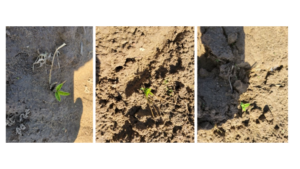
Considering these Kura establishment challenges, it was deemed fit to replant the entire trial afresh using remnant seed that had been sourced from the National Plant Germplasm System (NPGS) and The Land Institute (TLI). Briefly, 1416 seeds were started out in 72-cell seed trays in June of 2024. After two months (September 2024), the 567 seedlings that had successfully established were transplanted to 6-inch pots filled with potting mix that had been mixed with a NPK 13-13-13 fertilizer to enhance rhizome production. The pots were laid out in a greenhouse where they were provided natural lighting, regular watering and room temperature which has enhanced Kura growth, especially rhizome production. Overall, there are 204 families (128 families/accessions from NPGS and 76 from TLI), which have given rise to 567 genotypes (337 NPGS and 230 from TLI).
Owing to greenhouse space constraints, the 567 genotypes were separated into two groups i.e., 337 NPGS material and the 230 TLI genotypes. The 337 NPGS genotypes were first cloned at the end of January 2025 and are currently being managed in the greenhouse for rhizome production. Each plant/ genotype was cloned by cutting it vertically into four pieces (quarters) (Figure 2) without removing leaves and roots. With this method, the plant appears to have sufficient food reserves to sustain its establishment.
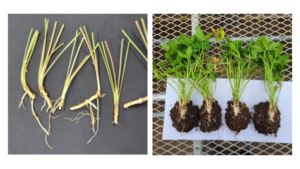
By the end of April, each of the clones will further be cloned as showed previously, consequently giving rise to a total of 16 clones per genotype. 12 of the 16 clones will be taken to the field for evaluated using three replications. The remaining 4 clones will be planted in 6-inch pots in the greenhouse to enable continuous production of planting material for the subsequent evaluations.
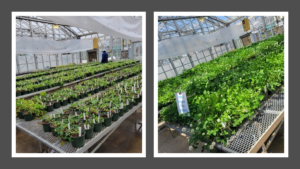
On the other hand, the 230 TLI genotypes were cloned at the end of February because they could not fit in the greenhouse altogether. So, these were cloned and immediately planted in the field at EV Smith Research Center. Following the drought event that affected the first clonal trial, it seemed prudent to use bigger pieces of Kura plant as planting material instead of the rhizomes that had been used previously. Indeed, the bigger pieces of planting material appear to establish better with promising results (Figure 4), and thus this is expected to be adopted for all trials. Each plot was a genotype that comprised a single row of 4 clones that were spaced 1.5ft within the row and 3 ft between rows.
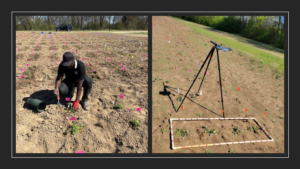 Figure 4: Field evaluation of the 230 TLI genotypes at EV Smith Research Center, Tallassee, AL. On the left is planting of Kura clover clones. Each row is made up of four clones of the same genotype, and these were planted at the end of February 2025. On the right is the same Kura clover field one month after. The tripod with mounted tablet camera, and the reference frame were used capture initial size of the clones. This will be repeated at the end of the evaluation to track changes in size/vigor.
Figure 4: Field evaluation of the 230 TLI genotypes at EV Smith Research Center, Tallassee, AL. On the left is planting of Kura clover clones. Each row is made up of four clones of the same genotype, and these were planted at the end of February 2025. On the right is the same Kura clover field one month after. The tripod with mounted tablet camera, and the reference frame were used capture initial size of the clones. This will be repeated at the end of the evaluation to track changes in size/vigor.
Spring 2025 – Summer 2026
Systematic germplasm evaluation will commence late Spring of 2025. Four of the sixteen clones will be evaluated in the greenhouse, while the remaining twelve clones for each genotype will be evaluated in the field at the Plant Breeding Unit (PBU) of EV Smith Research Center, Tallassee, Alabama. The experiment at PBU will comprise three replications with each plot constituting four clones spaced 3 ft between rows and 1.5 ft within rows. Both the greenhouse and field experiment will be evaluated using three seasons i.e., Summer 2025, Fall 2025 and Spring 2026. One major risk mitigation strategy is production of planting material in the greenhouse to ensure a sufficient, and timely supply of clones throughout the project. We have also secured sprinklers and water points to ensure sufficient moisture during periods of drought. The size of clones used as planting material is considerably bigger than what was used previously, and thus better trial survival is expected.
Obj 2: Develop Near Infrared Spectroscopy equations for rapid analysis of Kura forage quality traits.
We acquired a handheld NeoSpectra Near Infrared Reflectance (NIR) analyzer in July 2024. The NeoSpectra NIR analyzer was selected for its wide spectral range (1350nm to 2500nm) and versatility under field conditions (https://www.si-ware.com/neospectra-product-pages/neospectra-scanner) (Figure 5). Since the trial was replanted afresh, we are just yet to collect spectra from our first field trial that will be planted in the Summer of 2025. Spectra collection is thus expected by the end of Summer 2025 after the first harvests.
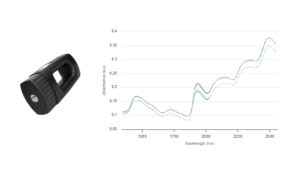
Obj 3: Study the genetic diversity of Kura Clover and the prospect to use genomics to accelerate breeding prospects.
Since the genomic information was also to be associated with field measurements, it was not possible to proceed with DNA sampling until another trial was replanted. Kura being an outcrossing species, each seed is genetically different, and thus replanting the entire trial implied having a completely different set of genetic material. Overall, we have collected DNA tissue samples from 561 genotypes that arose from a total of 204 families/accessions (128 from NPGS plus 76 from The Land Institute). These samples have been prepared and are undergoing lyophilization in the Chemistry Laboratory at Auburn University, after which they will be shipped to Arizona Genome Institute (AGI) in April 2025 for DNA extraction, from where they will finally be sent to the Joint Genome Institute for sequencing with separate funds from JGI Community Science Program. The waiting time for genotyping at JGI is roughly six months, and thus genomic data is expected by end of 2025. Once genomic data is available, the amount and nature of genetic diversity in Kura clover will be established. This genomic data will also be used to elucidate the nature of inheritance governing the cover and forage quality traits of Kura studied with funds from this SARE grant.
A comprehensive dataset is expected by the end of Summer 2025 after the first systematic evaluation of Kura germplasm under field conditions. This dataset will comprise spectra data, images that will be taken using a rover and field measurements including plant height, canopy cover, specific leaf area, above ground shoot weigh vigor and different morphological and morphological traits of Kura clover, which will enable us to study the inheritance of evaluated Kura clover traits. One of the popular applications used in biomass and canopy cover estimation is the Canopeo App. This App estimates the percent green cover in an image, which has been utilized in a substantial number of research experiments involving canopy measurements. We thus sought to understand if the Canopeo App could be used to measure canopy cover as a cover crop quality trait of Kura clover. Briefly, a smartphone digital camera was used to take images on Kura seedlings at a constant camera height and analyzed using Canopeo. Since the measurements provided herein were recorded on non-replicated single plants, the results presented are tentative and pending confirmation from larger plot-size evaluations in the replicated clonal trials to be planted in Summer 2025, Fall 2025 and Spring 2026. Mixed models were used to extract variance components associated with family effects using restricted maximum likelihood procedure. Based on the images analyzed using Canopeo, we observed moderate variation in canopy cover between families in the evaluated Kura population as shown in Figure 5. With the expected replicated experiments, we shall be able to partition the within and between family variance and estimate other genetic parameters important to guide breeding decisions in Kura clover.
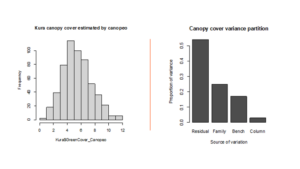
Educational & Outreach Activities
Participation Summary:
No educational or outreach activities at this point. A major focus has been to assemble Kura germplasm and multiplying it so that it can be evaluated for groundcover and forage quality traits.